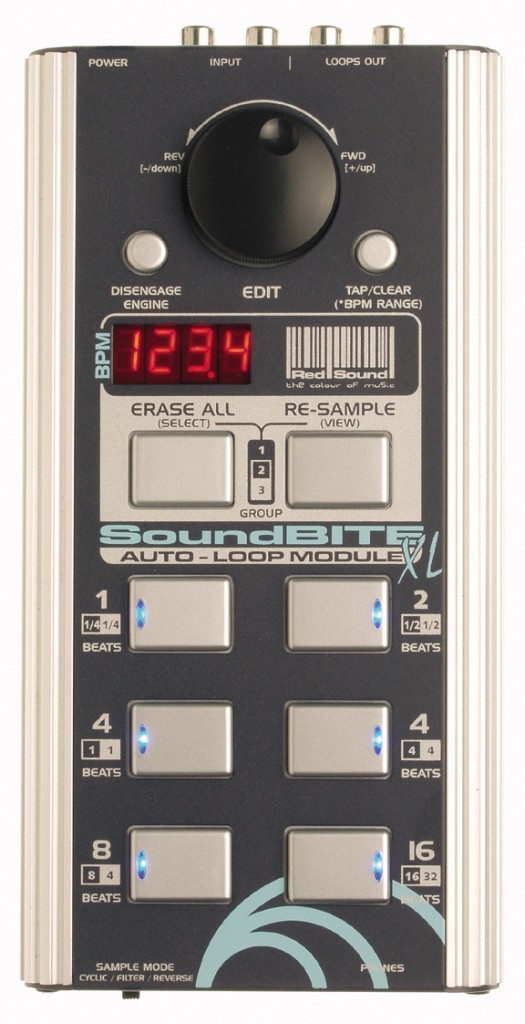 Firstly, this is not strictly a looper, but a loop sampler. It has 6 stereo loop memories of predefined length, but the length of the loop is measured in BPM rather than seconds. It attempts to latch on to the incoming sound and measure the BPM automatically, which for guitar based looping, fails miserably just about every time. However, it is easy to manually set the BPM prior to recording a loop (by either tapping in a tempo or manually selecting with the data wheel). The preset sample lengths are arranged in 3 groups, with the following possibilities;
Firstly, this is not strictly a looper, but a loop sampler. It has 6 stereo loop memories of predefined length, but the length of the loop is measured in BPM rather than seconds. It attempts to latch on to the incoming sound and measure the BPM automatically, which for guitar based looping, fails miserably just about every time. However, it is easy to manually set the BPM prior to recording a loop (by either tapping in a tempo or manually selecting with the data wheel). The preset sample lengths are arranged in 3 groups, with the following possibilities;
Group 1 – 16, 8, 4, 4, 2, 1 beats
Group 2 – 16, 8, 4, 1, 1/2, 1/4 beats
Group 3 – 32, 4, 4, 1, 1/2, 1/4 beats
The lowest BPM setting is 60, which would equate to sampling times of 16, 8, 4, 4, 2, 1 seconds for the pads ingroup 1, or a longest sample of 32 seconds in group 3. All in glorious stereo.
Inputs and outputs are on 2 pairs of phono (RCA) sockets at the top of the unit. There is also a handy headphone output at the bottom of the unit that allows only the input to be monitored – there is no sample output from this socket. I actually find this really useful, as It allows a clean signal feed on to my other devices.
Recording and playback is started by simply pressing one of the 6 sample pad buttons. This is quite awkward for a guitarist, and there is no option for footswitch or auto-trigger record start. I have modified my unit to provide footswitch control; this is relatively simple, although does require some fiddly soldering.
The recording continues to the end of the sample time, there is no way of shortening a loop.
There are some very neat features. It has a really nice sounding analogue filter, selectable HP, LP or BP which can filter either the sample pads or incoming ‘live’ signal. Unfortunately, the filter will work only on ALL the sample pads together, not individual samples. The filter resonance or cut off frequency is controllable via the large data wheel.
In addition, it has a handy reverse function which reverses any individual (or combination of) sample pads.
It is very simple to use, simply press a sample pad to start the recording, then the sample will automaticially playback and loop repeatedly at the end of the sample. If you make a mistake, simply press re-sample, then the sample pad again to re-record. All the pads continue playing in forward or reverse mode, all synced nicely together. If you need to time shift a sample, just press and hold a sample pad and joggle the data wheel to bring it forwards or backwards in relation to the other loops. It is also possible to time-shift all the samples simultaneoulsy, but this function is of limited use.
Individual samples can be turned off and on by pressing the sample pad once, when recorded. There is no way of erasing a single sample (but this is not neccesary, simply turn it off or re-record sample with silence). There is an Erase All samples button, which activates if held down for half a second. Its a bit too easy to accidentally erase everything, so approach this button with caution.
The output level of each individual sample can easily be set between -20dB and +6dB, although there is a ‘click’ as the OP goes from +5 to +6dB or vice versa. It would be nice if the OP could go below -20dB, as this doesn’t quite allow for a loop to be faded out completely (nearly though).
An undocumented feature is that, once a sample is recorded, the playback speed can be altered by changing the BPM setting. Again, this is a global feature affecting all samples, but allows for various pitch shifting effects.
This is a phrase sampler, and as such does not allow overdubbing of new material of course. However, one handy feature is that when re-sampling a loop, the old track you are recording over continues to play back. So, if you feed back some of that ‘old’ sample into the mixer and add it into the new sample mix, the old and new sounds will be overdubbed onto the new loop. This may seem a bit crude, but it actually seems to work OK. The process is non-reversible of course.
The sound quality is very good, and I have no reason to doubt the manuals specs of 24 bit 96kHz sampling. I would have personally prefered to have a 48kHz sample rate with longer sample time. The total possible sample time (at 60bpm) is 35 seconds (using group 1 samples), 29.75 seconds (using group 2) or 41.75 secs (group 3), but remember that these are split over 6 samples per group.
It is actually quite exciting to use this as a looper, and opens up certain possibilities for live use, provided you are able to cope with the fixed sample lengths. Recommended.
Further details can be found at http://www.redsound.com/images/SoundBITE_XL_manual.pdf
Redsound also produce the SoundBITE Pro and the SoundBITE micro.
Stephen Scott
 |
Kaoss Pads |
 |
TC-Helicon Voicelive Touch |
|
